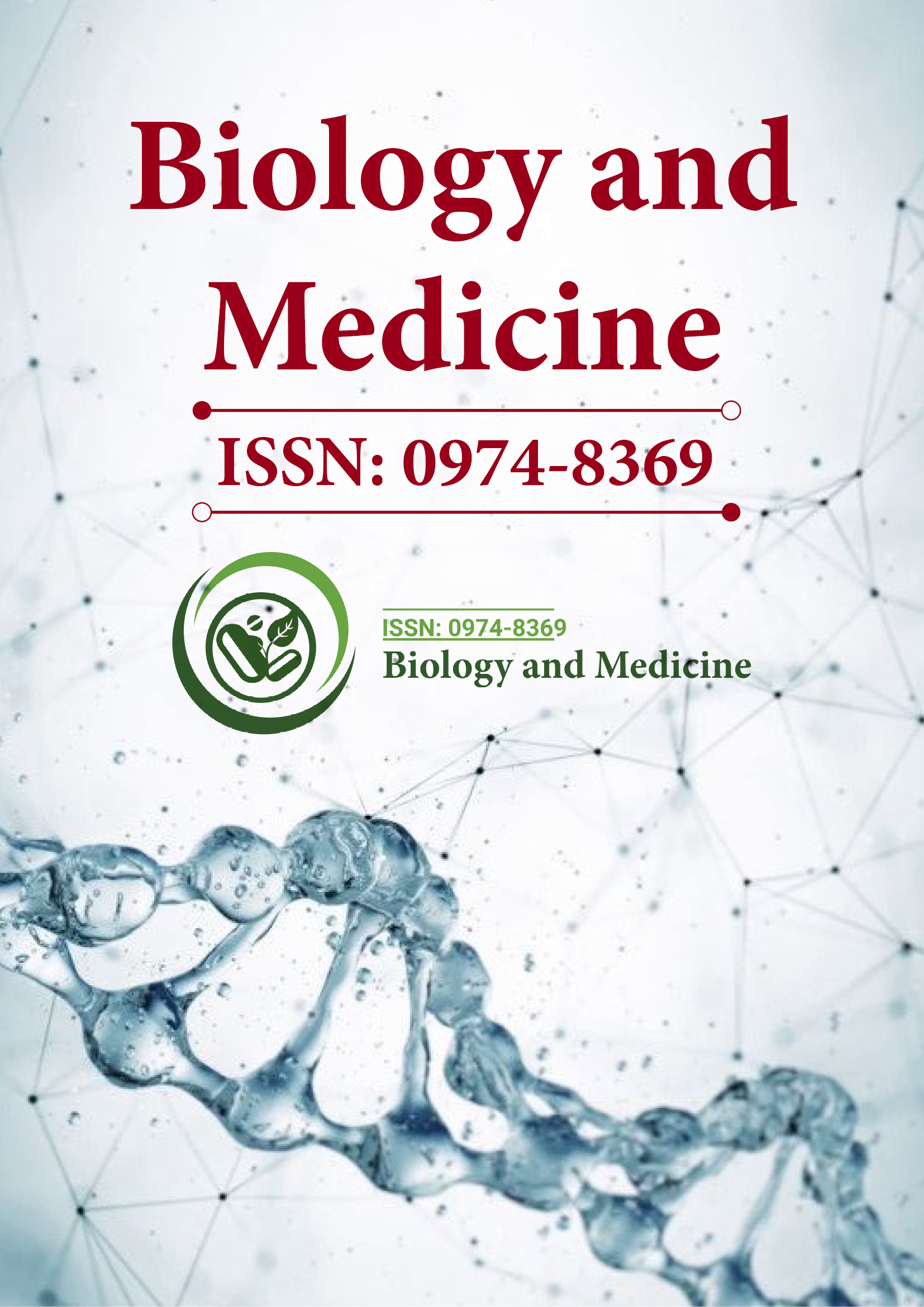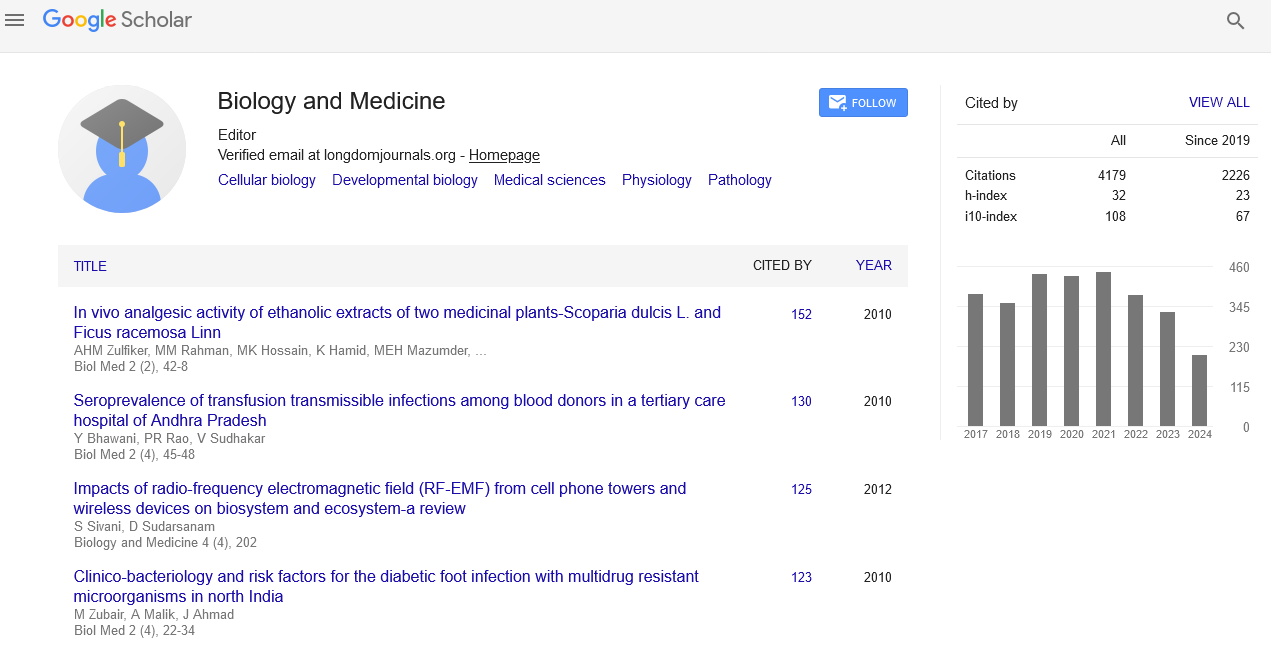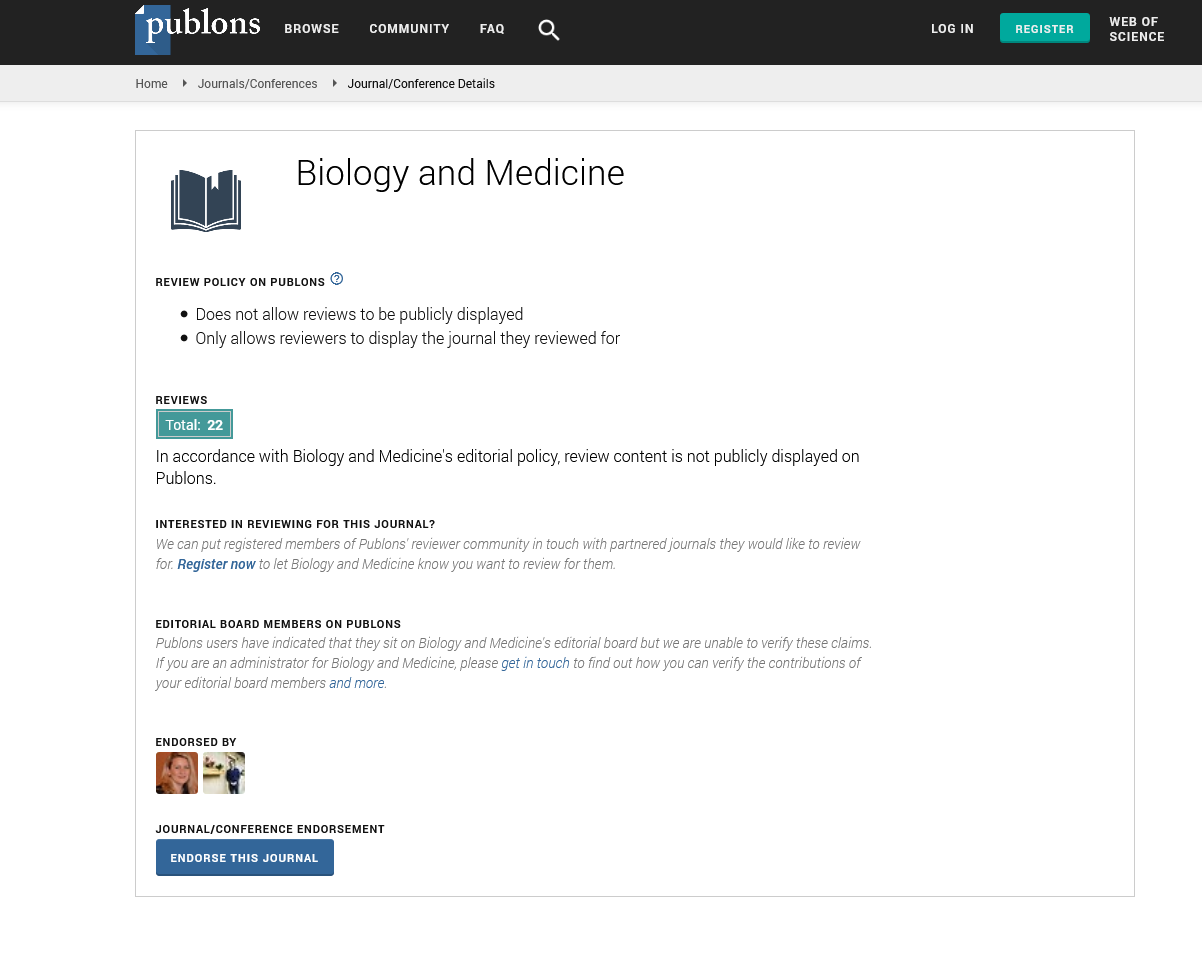Indexed In
- Open J Gate
- Genamics JournalSeek
- CiteFactor
- Cosmos IF
- Scimago
- Ulrich's Periodicals Directory
- Electronic Journals Library
- RefSeek
- Hamdard University
- EBSCO A-Z
- Directory of Abstract Indexing for Journals
- OCLC- WorldCat
- Proquest Summons
- Scholarsteer
- ROAD
- Virtual Library of Biology (vifabio)
- Publons
- Geneva Foundation for Medical Education and Research
- Google Scholar
Useful Links
Share This Page
Journal Flyer

Open Access Journals
- Agri and Aquaculture
- Biochemistry
- Bioinformatics & Systems Biology
- Business & Management
- Chemistry
- Clinical Sciences
- Engineering
- Food & Nutrition
- General Science
- Genetics & Molecular Biology
- Immunology & Microbiology
- Medical Sciences
- Neuroscience & Psychology
- Nursing & Health Care
- Pharmaceutical Sciences
Short Communication - (2020) Volume 12, Issue 1
Retrospective Review of 374 Samples, Circulating DNA; As a Biomarker Assay to Support Clinical Management in Solid Tumors Treated with Multi Targeted Epigenetic Therapy (MTET)
Nezami M1*, Klowsowski C2 and Hager SJ32Guardant Health, Genomic Specialist, Medical Affairs, Redwood City, California, USA
3California Cancer Associates for Research and Excellence, Fresno, California, USA
Received: 07-Sep-2019 Published: 03-Oct-2019, DOI: 10.35248/0974-8369.20.12.462
Abstract
Here in this abstract we retrospectively review preliminary findings on 374 samples of circulating DNA extracted from 173 patients treated by multi targeted epigenetic therapy (MTET), which is a combination of natural histone deacetylase inhibitors and DNMT methyltransferase inhibitors. This therapy could dynamically interrupt the expression of altered genes, in a variety of solid tumor types, both in in vitro and in vivo models. We hypothesize that serial monitoring of the circulating DNA provides a feasible option for therapeutic decisions making based on presence of the driver genes in these cases. We also were able to track the antineoplastic response in these groups of patients by monitoring their tumor circulating DNA mutated allele fractions and propose a direct correlation with interim epigenetic therapy effectiveness.
Keywords
Epigenetics; Liquid biopsy; Circulating DNA
Introduction
Our current understanding of cancer biology and the epigenetic science has transformed our ability to deliver therapies more precisely to the genetic and epigenetic targets driving the tumor growth and disrupting its behavior. In concert with our efforts to regulate the transcription of altered genes involved in tumor biology, we have emphasized a range of epigenetically regulated driver genes that control the tumor key molecular targets, involved with its growth and metastasis [1]. Statistical analysis on epigenetically driven targets had shown improved outcome compared to historical control [2].
Unfortunately epigenetic targets are dynamically expressed [3] and no single drug can clinically be used to target the epigenome as drugs have static mechanism of action. This limiting factor has caused researchers in the field to admit their failure in development of an epigenetic formula or product that has significant clinical impact in majority of cancer types, mainly solid tumors. As a result, the effort on epigenetic drug development has shifted in recent years to hematological cancers, such as lymphomas and leukemia where these drugs can make a difference in the clinic [4-13].
We earlier had shown that a combination of histone and DNA selective demethylators used in a specific protocol was able to significantly produce meaningful results in our experimental therapeutic models. Although cytotoxic therapies and targeted drugs have been studied in the recent years to correlate with such relevance, using liquid biopsy in different types of cancer, including lung [14-16], lymphoma [17], renal cancer [18], breast cancer [19-21], colon cancer [22-26], ovarian cancer [27,28], this is to our knowledge the first time this correlation with epigenetic drugs have been explored.
Materials and Methods
173 cases treated by MTET were collectively selected without selection bias. These cases were treated all in associated clinics of Medical centers of Hope.
The biomarker assays were performed through liquid biopsy through 374 samples. Amongst them 300 samples were positive for circulating DNA. 74 were negative. 66 patients had one sample and 63 patients had at least two samples (Tables 1 and 2).
Table 1: 374 samples sent through the end of May 2018 on 173 patients. More than 1/2 patients in the practice (61%) have had serial testing (2 or more G360 tests).
| Number of tests | Number of patients |
|---|---|
| 1 | 66 |
| 2 | 63 |
| 3 | 17 |
| 4 | 13 |
| 5 | 9 |
| 6 | 2 |
| 7 | 2 |
| 8 | 1 |
| Total | 173 |
Table 2: Other and miscellaneous category.
| Other/MISC | Count of cancer type |
|---|---|
| Anal Squamous Cell Carcinoma | 2 |
| Anaplastic Thyroid Carcinoma | 1 |
| Cancer, Other | 2 |
| Carcinoma of Unknown Primary (CUP) | 7 |
| Glioblastoma | 3 |
| Glioma | 1 |
| Neuroendocrine Carcinoma | 1 |
| Other | 17 |
| Other Squamous Cell Carcinoma | 1 |
| Thyroid Carcinoma | 4 |
| Grand Total | 42 |
Detection rate was 86 percent. The most and least common tumor types: 134 cases had breast cancer. 4 had glioblastoma. 20 cases carried BRCA alterations.
In average 64 percent of such cases were stage four and had no other viable options left.
Results
Serial monitoring of mutated allele fraction in circulating DNA analysis is feasible and clinically meaningful, when epigenetic drugs are applied in clinic and show positive clinical outcome based on such biomarker driven approach to epigenetic targets.
Further analysis as of April of 2019, for 491 cases is currently on going and preliminary findings are consistent with this article with common genetic mutations reflected in breast cancer responding to the epigenetic therapies. (Tables 3 and 4).
Table 3: Samples to date by cancer type, through end of April, 2019
| Cancer Category | Count of samples |
|---|---|
| Bladder | 7 |
| Bone/Soft Tissue | 14 |
| Breast | 186 |
| Cervix | 5 |
| Endometrial/Uterine | 11 |
| GI | 59 |
| Head Neck | 16 |
| Kidney | 7 |
| Lung | 34 |
| Prostate | 50 |
| Miscellaneous/Other* | 42 |
| Ovarian | 34 |
| Skin | 26 |
| Grand Total | 491 |
*Definitions on following slide
Table 4: FGFR4436 Common gene mutations breast cancer samples (genes identified 10 or more times in breast cancer samples to date).
| Gene | Observed in data |
|---|---|
| Grand Total | 644 |
| PIK3CA | 61 |
| TP53 | 44 |
| ERBB2 | 36 |
| ESR1 | 32 |
| NF1 | 32 |
| EGFR | 27 |
| ARID1A | 26 |
| KIT | 23 |
| MYC | 22 |
| CCND1 | 21 |
| BRCA1 | 20 |
| BRCA2 | 20 |
| FGFR1 | 20 |
| MET | 20 |
| APC | 18 |
| RAF1 | 16 |
| FGFR2 | 15 |
| PDGFRA | 14 |
| BRAF | 12 |
| GATA3 | 12 |
| CCNE1 | 11 |
| CKD6 | 10 |
| NOTCH1 | 10 |
| ERBB2 | 36 |
| CNV | 14 |
| SNV | 22 |
4/22 SNVs: activating
Conclusion
We conclude that such biomarker based epigenetic approach in cancer therapy could replace the current standard of care which is mainly blind shot and type specific.
REFERENCES
- Nezami M, Steve Hager DO, Klowsowski C. Retrospective review of 374 samples, circulating DNA; to support clinical management in solid tumors treated with multi targeted epigenetic therapy (MTET). J Cancer Ther. 2019.
- Nezami MA, Klowsowski C, Hager SJ. Predictive molecular tumor response through circulating DNA (cDNA) measurements and correlation with established prognostic markers in a series of solid tumors treated with multitargeted epigenetic therapy (MTET). J Clin Oncol ASCO. 2019;37.
- Feng W, Dong Z, He B, Wang K, Fenget. Analysis method of epigenetic DNA methylation to dynamically investigate the functional activity of transcription factors in gene expression. BMC Genomics. 2012;13:532.
- Sermer D, Pasqualucci L, Wendel HG, Melnick A, Younes A. Emerging epigenetic-modulating therapies in lymphoma. Nat Rev Clin Oncol. 2019;16(8):494-507.
- Lunning MA. Mutation of chromatin modifiers; an emerging hallmark of germinal center B cell lymphoma. Blood Cancer J. 2015;e361.
- Morin RD, Mendez-Lago M, Mungall AJ, Goya R, Mungall KL, Corbett RD, et al. Frequent mutation of histone-modifying genes in non-Hodgkin lymphoma. Nature. 2011;476(7360):298-303.
- Morin RD, Johnson NA, Severson TM, Mungall AJ, An J, Goya R, et al. Somatic mutations altering EZH2 (Tyr641) in follicular and diffuse large B cell lymphomas of germinal-cell origin. Nat Genet. 2010;42(2):181-185.
- Pasqualucci L, Trifonov V, Fabbri G, Ma J, Rossi D, Chiarenza A, et al. Analysis of the coding genome of diffuse large B cell lymphoma. Nat Genet. 2011;43(9):830-837.
- Pasqualucci L, Dominguez-Sola D, Chiarenza A, Fabbri G, Grunn A, Trifonov V, et al. Inactivating mutations of acetyltransferase genes in B cell lymphoma. Nature. 2011;471(7337):189-195.
- Chambwe N, Kormaksson M, Geng H, De S, Michor F, Johnson NA, et al. Variability in DNA methylation defines novel epigenetic subgroups of DLBCL associated with different clinical outcomes. Blood. 2014;123(11), 1699-1708.
- Juo YY, Gong XJ, Mishra A, Cui X, Baylin SB, Azad NS, et al. Epigenetic therapy for solid tumors: from bench science to clinical trials. Epigenomics. 2015;7(2):215-235.
- Nervi C, Marinis E, Codacci-Pisanelli G. Epigenetic treatment of solid tumours: a review of clinical trials. Clin Epigenetics. 2015;7:127.
- Sharma MR, Maitland ML, Ratain MJ. RECIST: no longer the sharpest tool in the oncology clinical trials toolbox-point. Cancer Res. 2012;72(20):5145-5149.
- Aggarwal C, Thompson JC, Black TA, Katz SI, Fan R, Yee SS, et al. Clinical implications of plasma-based genotyping with the delivery of personalized therapy in metastatic non-small cell lung cancer. JAMA Oncol. 2019;5(2):173-180.
- Guo N, Lou F, Ma Y, Li J, Yang B, Chen W, et al. Circulating tumor DNA detection in lung cancer patients before and after surgery. Nature scientific Reports. 2016.
- Sorensen BS, Wu L, Wei W, Tsai J, Weber B, Nexo E, et al. Monitoring of epidermal growth factor receptor tyrosine kinase inhibitor-sensitizing and resistance mutations, in the plasma DNA of patients with advanced non-small cell lung cancer during treatment with erlotinib. Cancer. 2014;120(24):3896-3901.
- Kurtz DM, Scherer F, Jin MC, Soo J, Craig AFM, Esfahani MS, et al. Circulating Tumor DNA Measurements As Early Outcome Predictors in Diffuse Large B-Cell Lymphoma. J Clin Oncol. 2018;36(28):2845-2853.
- Banumathy G, Cairns P. Signaling pathways in renal cell carcinoma. Cancer Biol Ther. 2010;10(7):658-664.
- Austrup F, Uciechowski P, Eder C, Bockmann B, Suchy B, Driesel G, et al. Prognostic value of genomic alterations in minimal residual cancer cells purified from the blood of breast cancer patients. Br J Cancer. 2000;83:1664-1673.
- Oshiro C, Kagara N, Naoi Y, Shimoda M, Shimomura A, Maruyama N, et al. PIK3CA mutations in serum DNA are predictive of recurrence in primary breast cancer patients. Breast Cancer Research Treat. 2015;150(2):299-307.
- Liang DH, Ensor JE, Liu ZB, Patel A, Patel TA, Chang JC, et al. Cell-free DNA as a molecular tool for monitoring disease progression and response to therapy in breast cancer patients. Breast Cancer Res Treat. 2016;155(1):139-149.
- Zhao B, Lee SM, Lee HJ, Tan Y, Qi J, Persigehl T, et al. Variability in assessing treatment response metastatic colorectal cancer as a paradigm. Clin Cancer Res. 2014;20(13):3560-3568.
- Garlan F, Laurent-Puig P, Sefrioui D, Siauve N, Didelot A, Sarafan-Vasseur N, et al. Early Evaluation of Circulating Tumor DNA as Marker of Therapeutic Efficacy in Metastatic Colorectal Cancer Patients (PLACOL Study). Clin Cancer Res. 2017;23(18):5416-5425.
- Kurtz DM, Scherer F, Jin MC, Soo J, Craig AFM, Esfahani MS, et al. Circulating Tumor DNA Measurements As Early Outcome Predictors in Diffuse Large B-Cell Lymphoma. J Clin Oncol. 2018;36(28):2845-2853.
- Guarner C, Soriano G. Bacterial translocation and its consequences in patients with cirrhosis. Eur J Gastroenterol Hepatol. 2005;17(1):27-31.
- Fiore M, Leone S. Spontaneous fungal peritonitis: Epidemiology, current evidence and future prospective. World J Gastroenterol. 2016;22(34):7742-7747.
- Murtaza M, Dawson SJ, Tsui DW, Gale D, Forshew T, Piskorz AM, et al. Non-invasive analysis of acquired resistance to cancer therapy by sequencing of plasma DNA. Nature. 2013;497(7447):108-112.
- Bast RC Jr, Xu FJ, Yu YH, Barnhill S, Zhang Z, Mills GB. CA 125: the past and the future. Int J Biol Markers. 1998;13(4):179-187.
Citation: Nezami M, Klowsowski C, Hager SJ (2020) Retrospective review of 374 sample, circulating DNA; as A biomarker assay to support clinical management in solid tumors treated with multi targeted epigenetic therapy (MTET). Biol Med (Aligarh) 12: 462. doi: 10.35248/0974-8369.20.12.462
Copyright: © 2020 Nezami M, et al. This is an open-access article distributed under the terms of the Creative Commons Attribution License, which permits unrestricted use, distribution, and reproduction in any medium, provided the original author and source are credited.


